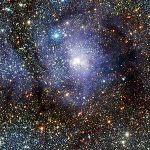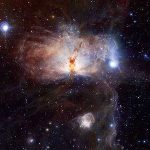VISTA is a 4-m class wide-field survey telescope equipped with an IR camera and located at ESO’s Cerro Paranal Observatory in Chile. It is one of the most capable IR imaging survey instruments in the world.
The IR camera for VISTA is composed of 16 Raytheon VIRGO 2048×2048 20 micron pixel array detectors, with a pixel scale of 0.34″ (f/3.25) and a field of view per exposure of 0.59 square degrees. Each detector is divided into 16 channels of 128×2048 pixels. The detectors are spaced at 90% and 42.5% of the detector width. Six exposures (known as pawprints) are required to survey a contiguous area (tile) of 1.5 square degrees.

VISTA has eight filter housings including the broadband set ZYJHKs and a narrow band filter at 1.185μm. There is one filter wheel position available to hold a further filter. The eighth filter housing is blanked for darks.
The scientific goals of the VISTA surveys, which started in 2010, include many of the most exciting problems in astrophysics today, ranging from the nature of dark energy to the threat of near-Earth asteroids.
There are six large public surveys being conducted by VISTA: UltraVISTA, VIKING: VISTA Kilo-Degree Infrared Galaxy Survey, VMC: VISTA Magellanic Survey, VVV: VISTA Variables in the Via Lactea, VHS: VISTA Hemisphere Survey, VIDEO: VISTA Deep Extragalactic Observations Survey. These have taken up the majority of the observing time in the telescope’s first five years of operations. The surveys cover different areas of sky to different depths to attack a wide range of scientific questions.
More information about each of the VISTA surveys can be found on the ESO — VISTA Surveys website.


